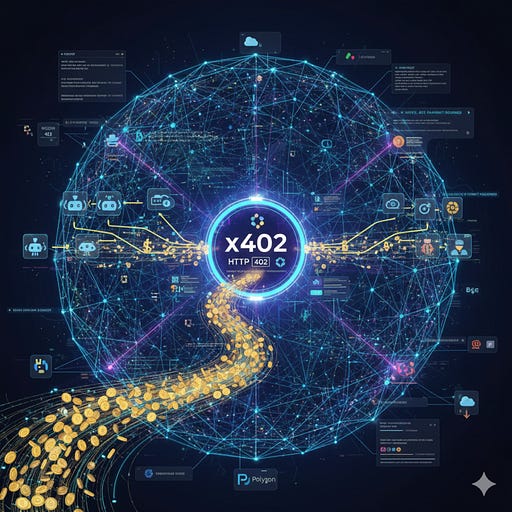The internet’s fundamental architecture was designed for information exchange, not value exchange. This inherent limitation has led to a fragmented, friction-filled digital payment landscape dominated by accounts, subscriptions, and intermediaries. Enter x402, an open payment protocol that fundamentally re-engineers how value is exchanged on the web, promising a transformative shift for onchain payments.
Spearheaded by Coinbase and backed by industry leaders like Cloudflare, x402 is built on the familiar backbone of the internet: HTTP (Hypertext Transfer Protocol).
What is x402?
At its core, x402 is an open standard that revives the long-dormant HTTP 402 “Payment Required” status code. This previously unused status is now an active component of the web’s language, enabling services to natively request an instant, onchain payment from a client.
In simple terms, x402 integrates a clear, machine-readable payment flow directly into a standard web request-response cycle.
How the x402 Payment Flow Works:
- Request: A client (a user, an application, or an AI agent) makes a standard HTTP request to a resource (e.g., an API endpoint, a piece of premium content).
- Payment Required: If the resource is protected, the server responds with an HTTP 402 Payment Required status code. This response includes crucial details in the headers, such as the required stablecoin amount, the accepted blockchain network (like Base or Polygon), and the recipient’s wallet address.
- Payment Execution: The client’s wallet software automatically reads the instructions, generates a cryptographically signed payment payload (often leveraging standards like ERC-3009 for gasless transfers), and re-sends the original request with the payment data included in an X-PAYMENT header.
- Access Granted: A third-party Facilitator (an optional but common service) instantly verifies the signed payment on the specified blockchain. Once confirmed, the server delivers the requested resource to the client.
This entire process is stateless (no accounts, sessions, or complex authentication needed) and happens in a matter of seconds, leveraging the speed of modern Layer 2 (L2) blockchains.
Why x402 is Transformative for Onchain Payments
The protocol’s impact extends far beyond a simple transaction upgrade. By embedding instant, direct stablecoin payments into the internet’s core infrastructure, x402 unlocks a new paradigm for digital commerce.
1. Enabling the Autonomous Economy (AI Agents) 🤖
This is arguably x402’s most disruptive potential. Legacy payment systems were designed for humans; they require accounts, credit cards, and manual authorization, which makes them unsuitable for machine-to-machine commerce.
- Autonomous Transactions: With x402, AI agents can pay for resources autonomously and programmatically. An AI could, for instance, access a high-value data feed from one API, pay a micro-transaction fee for each query, and then use that data to purchase compute power from another service, all without human intervention.
- Micropayments as the Norm: The high cost and slow settlement of traditional processors make low-value transactions (micropayments) impractical. Onchain stablecoin payments through x402, particularly on low-cost L2 networks, make pay-per-use models viable down to fractions of a cent, directly fueling the agent economy.
2. Eliminating Friction and Intermediaries 💸
x402 removes many of the obstacles that plague traditional digital commerce:
- No Accounts or Subscriptions: Users or agents simply need a compatible crypto wallet. The payment is processed with no need for a pre-existing account, reducing user friction and improving privacy. This allows for true usage-based pricing instead of forcing users into fixed monthly subscriptions.
- Instant, Final Settlement: Unlike credit card transactions, which involve multiple intermediaries and can take days to settle (and are subject to chargebacks), x402 payments are settled directly on a public blockchain in seconds. This provides instant finality and eliminates the risk of chargebacks for sellers.
3. Open Standard and Web-Native Integration 🌐
By leveraging the HTTP 402 status code, x402 is not a proprietary app or a new siloed payment rail; it’s an open standard designed to work with the existing internet.
- Developer-Friendly: Developers can implement x402 with simple middleware, integrating onchain payments directly into their existing web server stacks without needing to manage complex blockchain infrastructure or maintain their own billing systems.
- Chain-Agnostic: While initial deployments use stablecoins on networks like Base, the protocol is designed to be blockchain-agnostic, meaning it can be extended to support any network or payment method that adheres to the standard.
The Road Ahead
x402 transforms the web from a free-information zone supported by advertising and cumbersome subscriptions into a true commerce layer where value can flow as freely as data. While its immediate use cases focus on monetizing APIs and premium digital content, its long-term potential lies in becoming the standard protocol for autonomous commerce, paving the way for a more efficient, decentralized, and machine-friendly internet economy.
x402: The Protocol Revolutionizing Onchain Payments for the Internet Age was originally published in The Capital on Medium, where people are continuing the conversation by highlighting and responding to this story.
